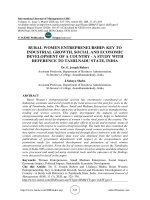Economic growth and economic development 188
Bạn đang xem bản rút gọn của tài liệu. Xem và tải ngay bản đầy đủ của tài liệu tại đây (68.26 KB, 1 trang )
Introduction to Modern Economic Growth
also see in Chapter 14 that the process of Schumpeterian creative destruction, where
new firms improve over and destroy incumbents, is an essential element of economic
growth. Schumpeterian creative destruction requires a level playing field, so that
incumbents are unable to block technological progress. Economic growth based
on creative destruction therefore also requires economic institutions that guarantee
some degree of equality of opportunity in the society.
Another question may have already occurred to the reader: why should any
society have economic and political institutions that retard economic growth? Would
it not be better for all parties to maximize the size of the national pie (level of GDP,
economic growth etc.)? There are two possible answers to this question. The first
takes us back to multiple equilibria. It may be that the members of the society
cannot coordinate on the “right,” i.e., growth-enhancing, institutions. This answer
is not satisfactory for the same reasons as other broad explanations based on multiple
equilibria are unsatisfactory; if there exists an equilibrium institutional improvement
that will make all members of a society richer and better off, it seems unlikely that
the society will be unable to coordinate on this improvement for extended periods
of time.
The second answer, instead, recognizes that there are inherent conflicts of interest within the society. There are no reforms, no changes, no advances that would
make everybody better off; as in the Schumpeterian creative destruction stories,
every reform, every change and every advance creates winners and losers. Our
theoretical investigations in Part 8 will show that institutional explanations are intimately linked with the conflicts of interests in society. Put simply, the distribution
of resources cannot be separated from the aggregate economic performance of the
economy–or perhaps in a more familiar form, efficiency and distribution cannot be
separated. This implies that institutions that fail to maximize the growth potential
of an economy may nevertheless create benefits for some segments of the society,
who will then form a constituency in favor of these institutions. Thus to understand
the sources of institutional variations we have to study the winners and losers of
different institutional reforms and why winners are unable to buy off or compensate
the losers, and why they are not powerful enough to overwhelm the losers, even
when the institutional change in question may increase the size of the national pie.
174









